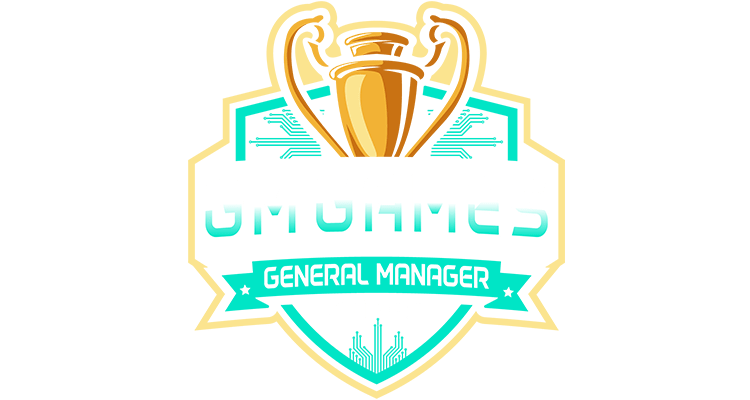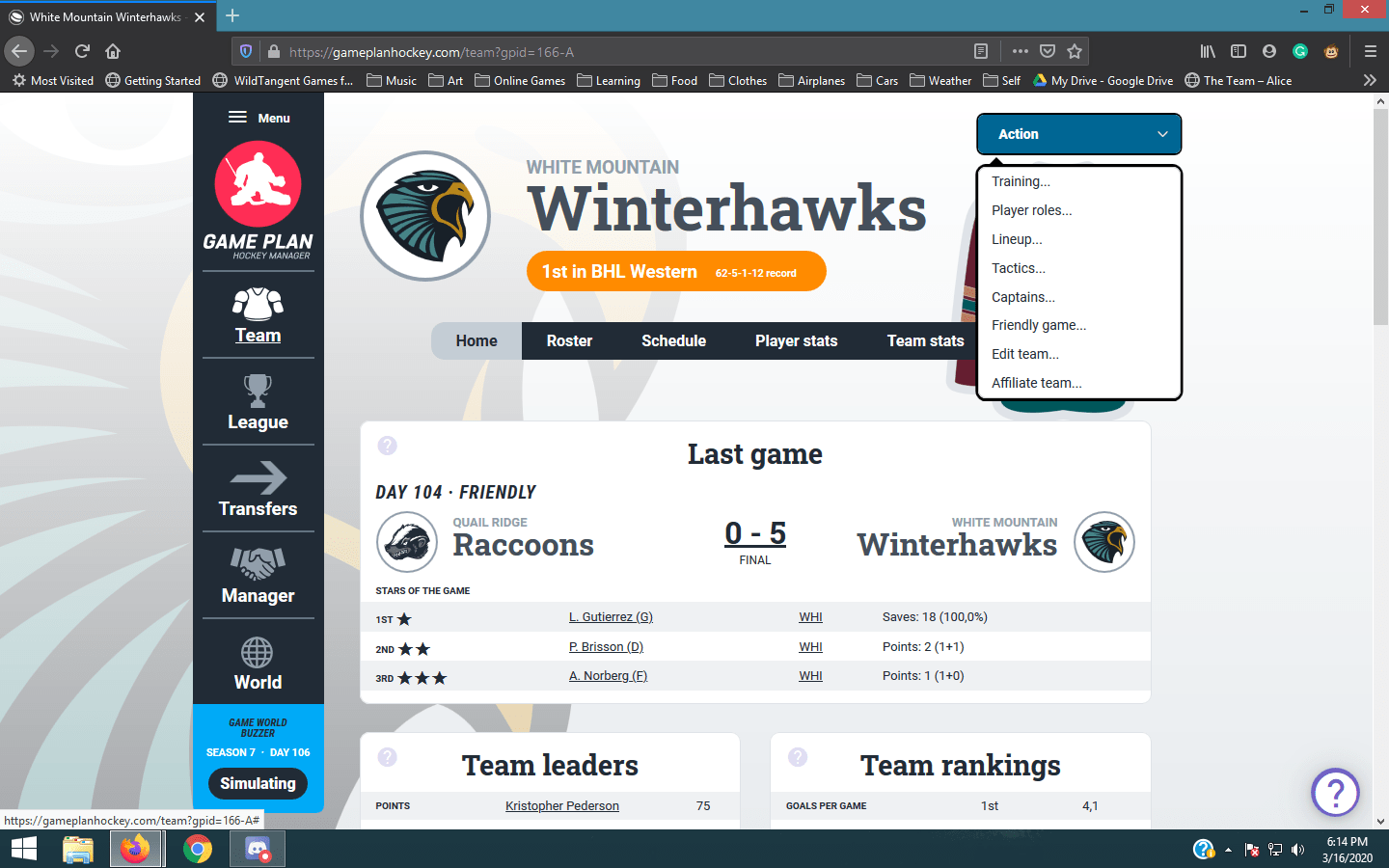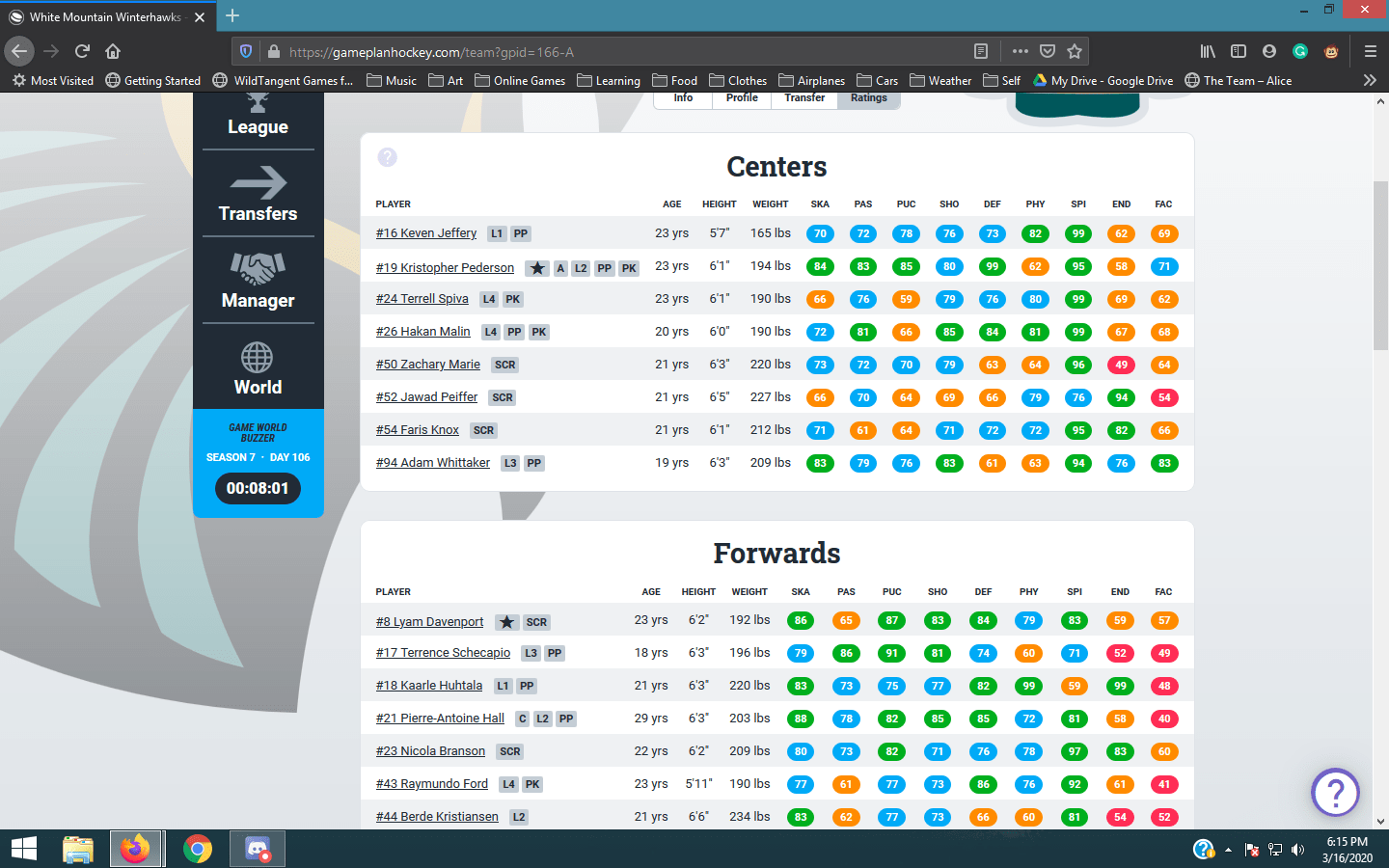Before I start the review of Game Plan Hockey Manager I have to note a few things. First, the game has only two people working on it and they work on it in the spare time that they have in their busy lives. Second, this game has a $1.99 monthly subscription fee. It has a one month free trial though for anyone that wants a taste before they jump in. Finally, I have been playing this game since June of 2015. I enjoy the game. There is going to be some degree of bias as a result. I am going to try to remove as much as possible for the review.
Game interface
The game interface itself has a rather basic look and isn’t that flashy. It sticks to being rather basic, outside of the ever present faded, large team logo in the background on the left, while having a few nice touches here or there depending upon where you are in the menus. On the team page there is a team jersey in the top right with the logo and team name on the front. If you are on a player page there is a team jersey with the player’s last name and number on the back. It is a nice small touch to an otherwise simple visual interface.
The game interface is the first thing you have to deal with and learn in a game. Some games have amazing interfaces that make things very easy and straightforward to find and get to. Other games have convoluted and complex systems that are confusing to say the least. GPHM falls somewhere in the middle. Thankfully though, it isn’t convoluted. It is just spread out across the screen in three parts, technically four if you want to include looking for the game forums. As a result, it is more complex than it really needs to be. Once you learn where everything is it isn’t as much of an issue.
On the left is the main menu. It has everywhere major you would want to go in the game right there. Across the middle of the top is the sub-menu for wherever you might be at the time. If you are in the team page in the main menu you will see in the sub menu; the team home page, the player page, schedule page, player stats page, team stats page and finally the team info page. The third menu is in the top left labeled action and in a big blue button. So let’s call it the action menu.
The action menu is where you will do most everything. It is where you adjust lines and tactics on your team page. It is where you have to go to negotiate contracts, assign players to your minor league team, or even call them up. This menu system isn’t as straightforward and streamlined as I think it could be but it is a rather simple one that is easy to navigate once you learn it.
Game systems
Game systems involve the sim engine, AI team behaviors and everything else that runs the game. For GPHM this is, again, a bit of a mixed bag. Mostly, it is good with only a few negatives.
First and foremost is the fact that you are a manager of a team in one of three game worlds. Attack, buzzer and cage. The three leagues are the same size and all behave the same outside of one significant difference. The speed that each world runs at. Attack simulates four days in one real life day. Buzzer simulates two days in one real life day and cage simulates one day for one real life day. Outside of that, they all behave the same.
Each game world has a number of other human managers that you will also be playing against as well as some AI controlled teams. The teams are in tiered leagues. With 6 leagues and 28 teams a league. The teams are split into two conferences with 3 teams being demoted and promoted to the league above and below respectively. The top league has a playoff system instead involving the 8 best teams in each conference playing for the championship of the game world.
The simulation engine itself does a good job of keeping games rather realistic numbers wise. While the numbers in game don’t match the NHL, as it is rather difficult to get a player to have more points than games if they are playing equally skilled competition for example, the numbers it puts out are more than believable for what you might see from a hockey game/league. For one person to have made a simulation engine this good I am honestly impressed.
A big key of the results from the simulation engine is the tactics that both teams choose to use. This is where this game shines the most. The tactics in the game are very simple and straightforward. It is very easy to learn yet at the same time difficult to master. It is actually quite impressive to me how such a simplified system tactically can also be so deep and complex at the same time.
There are four offensive systems and five defensive systems to choose from for your team on the whole. There are also individual powerplay and penalty kill options. Each has their strengths and weaknesses with different types of players being preferred in each. Each line then has four line specific options to dictate the role that each individual line would play in that system. The players then have roles that you assign to them. Giving the players roles that match up with their skills as well as what you want their line to do is another key part and where the deep complexity starts.
The players also have profiles that have them all behave in their own ways. This adds to the complexity. In fact, the players are where almost all of the complexity lies. The team tactics themselves are very simple and straightforward making the game very friendly to new players in this regard. The added complexity from the players ensures that the game keeps challenging the more experienced managers while allowing for success to be found with no one tactic being the answer.
The players progress through their careers as one would largely expect. There is one exception though that I think is worth mentioning here. Players with a lazy attitude to hockey have a chance of retiring earlier than you would expect from their careers. Players also have individual skill caps too. Not everyone is great at everything. This creates variety in terms of the skills that players will bring. Beyond that, players will progress through their careers as you would expect.
Setting up the lineup for your team is rather easy. When you bring up the lineup of your team it first shows you your first forward and defensive lines as well as your goalie tandem. Changing the players is as simple as clicking on a jersey and then selecting a player from the positional list of players on your roster. The positional list is broken into centers, forwards, defensemen and goalies. The only difficulty is that it is easy to put more than the allowed number of players into the lineup. If you do that you have to go through the lineup trying to find where the extra player, or players, is in the lineup.
Negotiating player contracts is rather straightforward too. A screen pops up with their demands and your ability to offer what contract you want to try to sign them for. You can change the term (money) and length of the deal. Player response is immediate and you can adjust the contract offer as desired. It is the easiest, most friendly system I have personally encountered.
There is no money or building management in this game. You aren’t the CEO or owner. You are just the GM/coach. Your only concern is building your team, setting the lineup and training your players. That said, there is a cap that you have to deal with.
Training your players is probably too straight forward though. There are 3 training settings and 3 focuses.The settings are easy, medium and hard with the focuses being offense, defense and balanced. Very simple and straightforward. There is no reason to ever have training on anything but hard in terms of the three settings. Players have enough endurance that most can train on hard and never get tired while playing all of the games. It brings into question the relevance of the other two options.
Finally I have to mention the weakest part of this game. The AI behavior. It plays players in the wrong positions and trains them poorly. Its trade logic is also deeply flawed to say the least. This is, in part, due to the vague trade values. Even then, the AI offers up incredibly one sided trade deals that make no sense. In an environment where there is a mix of human managers and AI managers there is the point to be made where you don’t want the AI to be too good. This is very true, but you ideally don’t want it this bad either.
Customization
Customization of your team is possible via a number of city names, team names and jersey options including various stripe patterns and the colors of the jersey. Your options are somewhat limited and you cannot create your own for legal reasons. Professional teams are trademarked after all. That said, what is available currently is plenty enough for you to have your own unique jersey unless you happen to try to recreate a real life teams jersey. Beyond these team customization options there is nothing else.
Conclusion
GPHM is a game being developed by two people in their spare time. That means that it has some flaws. At the moment of writing this the scouting system is frozen while the rest of the world is running as it should. That said, the game is constantly being developed and improved. Fixes and improvements just take time as it is a two man team working on the game in their spare time.
Issues aside, it is very easy to pick up and play once you learn the menus systems as the tactical system in the game is rather simple and straightforward. It offers an easy to learn upfront management game where you can face off against other human managers as well as AI controlled teams.
If you are interested in giving the game a shot but are wary of the subscription fee there is a one month free trial available. I would recommend you give the free trial a try and play a month in the attack world. You will get the largest taste of the game possible in the trial time even though the pace will be absolutely crazy for new players. If you are interested in sticking around after the trial expires and are willing to pay the subscription fee there is always the option of resigning from the team in attack and going to one of the two slower leagues should a more slower pace be desirable.
Good: Straightforward game making it easy to learn. Tactics are simple and easy to learn while still having enough tactical depth to be complex without being overwhelming. Player progression is believable. Good team customization options, albeit basic and limited. No owner duties.
Bad: Outside of the free monthly trial it has a $1.99 subscription fee. Only two people working on development and bug fixes means that any issues that prop up may take time to iron out. Menu system is a bit more complex than it likely needs to be, at least it isn’t difficult to navigate once learned. If you want the owner’s experience you won’t find it here as you are only the GM. Very poor AI behavior. No in match experience as of yet.
Walkthrough Video
Leave rainsilent or GM Games a comment on reddit, or come chat on the GPHM Discord Server…






